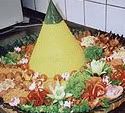
Ikat
 Ikat, or Ikkat, is a style of weaving that uses a resist dyeing process similar to tie-dye on either the warp or weft before the threads are woven to create a pattern or design. A Double Ikat is when both the warp and the weft are tie-dyed before weaving.
Ikat, or Ikkat, is a style of weaving that uses a resist dyeing process similar to tie-dye on either the warp or weft before the threads are woven to create a pattern or design. A Double Ikat is when both the warp and the weft are tie-dyed before weaving.Ikat means "to tie" or "to bind" in the Malay language and has the same root as the words dekat ("close"), lekat ("to stick"), pikat ("to catch") etc. The word Katt has the same meaning in all of the south Indian languages but there may be no relation. Through common usage, the word has come to describe both the process and the cloth itself. Ikats have been woven in cultures all over the world. In Central and South America, Ikat is still common in Argentina, Bolivia, Ecuador, Guatemala and Mexico. In the 19th century, the Silk Road desert oases of Bukhara and Samarkand (in what is now Uzbekistan in Central Asia) were famous for their fine silk Uzbek Ikat. India, Japan and several South-East Asian countries have cultures with long histories of Ikat production. Double Ikats can still be found in India, Guatemala, Japan and the Indonesian islands of Bali and Kalimantan.
Like any craft or art form, ikats vary widely from country to country and region to region. Designs may have symbolic of ritual meaning or have been developed for export trade. Ikats are often symbols of status, wealth, power and prestige. Perhaps because of the difficulty and time required to make ikats, some cultures believe the cloth is imbued with magical powers.
The History of Ikat
There are known links between ikat production in India and South-East Asia. Patola cloth, a double ikat from Gujarat, western India, used to be exported to Indonesia for the use of the royal families. As early as the fifteenth century Gujarati merchants brought patola to Indonesian rulers, an activity taken over by the Dutch at the beginning of the seventeenth century to gain concessions in the spice trade.
The patterns in the Patola Ikats are strikingly similar to the double ikats produced in Bali, Indonesia. Ancient trading routes linked India and South-East Asia, like Cambodia and also linked Central Asia with India. Because woven fabric rarely survives for more than a few centuries it is extremely difficult, if not impossible, to determine where the technique of Ikat originated. It probably developed in several different locations independently. Ikat was known to be produced in several pre-Columbian Central and South American cultures. Ikat floral patterns are traditionally used in Europe on Mallorca, Spain.
How Ikat is Made
Ikats created by dyeing the warp are the easiest to make. Before the warp strings are attached to the loom they are arranged into bundles. Each bundle is tied and dyed separately, so that a pattern will emerge when the loom is set up. This takes a good deal of skill. The tightly bound bundles are sometimes covered with wax or some other material that will keep the dyes from penetrating. The process is repeated several times for additional colors.
Some patterns have many strands in the cloth that are all dyed the same way which creates a blocky design. In some weaving traditions each strand of the cloth may be dyed differently from the ones next to it. Usually the pattern repeats in symmetrical or asymmetrical ways. In the illustration above, the right side of the weaving is identical to the left. To make these elaborate patterns the weaver will still bundle and dye several threads together, but when the loom is prepared, a single thread will be used from each bundle for each section of the pattern. Elaborate ikat patterns like this are often handed down from generation to generation in the same family.
After the threads are dyed the loom is set up. The pattern is visible to the weaver when the dyed threads are used as warp. Threads can be adjusted so that they line up correctly with each other. Some ikat styles (like in Japan and Guatemala) don't try to get the patterns precisely lined up, others (like in Timor in Indonesia) the patterns are so accurate, that you have to look closely to determine that the pattern was not printed on the cloth.
Dying the weft makes it much more difficult to make ikats with precise patterns. The weft is one continuous strand that is woven back and forth, so any errors in how the string is tied and dyed are cumulative. Because of this, weft ikats are usually used when the precision of the pattern is not the main concern. Some patterns become transformed by the weaving process into irregular and erratic designs. However, the precise images of Japanese ikats are made from weft ikat when they are not double ikats.
Double ikats are the most difficult to produce. In the finest examples from India and Indonesia, the warp and the weft are precisely tied and dyed so that the patterns interlock and reinforce each other when the fabric is woven.
The most precise ikat is the Japanese oshima -- thrice-woven cloth. The warp and weft threads are used as warp to weave stiff fabric, upon which the thread for the ikat weaving is spot-dyed. Then the mats are unraveled and the dyed thread is woven into oshima cloth.
Other Variants
In Thailand the local ikat type of woven cloth is known as Mudmee or Mudmi. Traditional Mudmi cloth was woven for daily use among the nobility. Other uses included ceremonial costumes and Buddhist monks' robes. Nowadays it is mostly sold in the tourist market.
This type of cloth is the favorite silk item woven by ethnic Khmer people living in southern Isaan, mainly in Surin, Sisaket and Buriram. (source)
Related articles :



















0 comments:
Post a Comment